
All content & writing by Brad Jaeger © The NACHTKABARETT
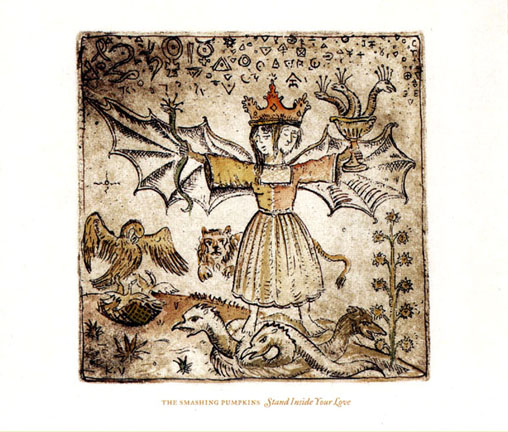 Original Source: The Single for Stand Inside Your Love
Original Source: The Single for Stand Inside Your LoveThe cover of Stand Inside Your Love is primarily a depiction of the alchemical androgyne, one of the most significant symbolic representations within alchemy, and, on its most basic level, represents the perfect union between man and woman when joined as a single entity. Atop their head is a single crown, known to the Kabbalists as Kether, the source of all creation, and the first Sephiroth on the Tree of Life.
The androgyne denotes the beginning of human history, when men and women were originally formed as a single androgynous being, harmonious and in union with all that ever was or is. Our androgynous body and spirit was gifted with the perpetual state of sexual, intellectual and spiritual bliss. Since the split of the androgyne by a vengeful God -- be it Jehovah, Zeus or any one of the plethora of makers who look upon their creation with contempt -- the alchemist has continually sought ways to return to the perfection of androgyny.
This plays a large role in why concepts and symbols surrounding the masculine and feminine, mercury and sulfur, sun and the moon, king and queen, and a host of other dichotomies, are so prevalent. It isn't the dualistic nature of the halves that attracted the alchemist, but rather, the potential of the whole upon uniting the two halves. This is at the very heart of alchemical symbolism, and the androgyne was perhaps the most fitting example of such unity.
Androgynous figures are a mythology shared by the collective mind of numerous cultures around the world. At times, the androgyne would be represented as a singular being, other times as twin counterparts. Apart, they would represent either the male or the female qualities of the androgyne.
Here is a shortened and far from complete list of androgynous figures world wide:
- Gemini: Astrological figure otherwise known as "the twins"
- Adam & Eve: Bisexual androgyne to many Gnostic Christians and Persian influenced Jewish sects. Promoters of this belief claim that Eve was not born from the ribs of Adam; rather, the harmonious alchemical union of Adam & Eve was torn apart by a vengeful and jealous God, infuriated by the sexual and spiritual bliss shared in androgyny.
- Christ & Sophia: Regarded by the Gnostics as paired Aeons. In order to unlock the mysteries, one must have a perfect understanding of the union between Christ and Sophia.
- Brahma & Vishnu: When united by their Shaktis, was regarded as a bisexual being
- Jana & Janus: Twin Roman God and Goddess
- Ardhanarisvara: The androgynous union of Shakti-Kali & Shiva
- Yin-Yang: Students of the Tao recognize the flux of male and female energies
- Isis & Osiris: Fraternal twins and husband and wife, together were often called, "the divine androgyne"
- Hermaphroditus: The androgynous union of Hermes and Aphrodite (Incidentally, this is where we derive the present day term 'hermaphrodite')
- Diana & Dianus: Twin Roman God and Goddess
- The Devil / Demons: So hated was the concept of the androgyne to the traditional orthodox church, that many depictions of the devil or his lesser demon minions were depicted as androgynous, supposedly reflecting their "inherently sinful" nature
- Apollo & Artemis: Roman Sun God and his female counterpart Moon Goddess
- The Tarot: Prince & Princess, King & Queen
- The Eyes of Horus: Egyptian mythology states that when Horus was murdered by his brother Seth, his left eye was ripped out. Thoth, being a god of magic and arts, restored his eye. This united Horus, a God associated with the sun, with Thoth, a God associated with the moon. With the sun denoting active male energy and the moon representing the passive female energy, this mirrored the alchemical union of the androgyne.
- Tantric sexual union: Taught to be prolonged, as the act of sex reunites man and woman, bringing them into union as one.
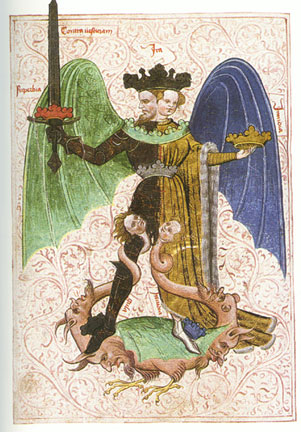 |
 |
| Two depictions of the androgyne | |
Alchemy & Mysticism: The Hermetic Museum, by Alexander RoobLeft: "Ulmannus (early 15th century) began, Jacob Böhme, with man's free choice between the worlds of wrath and love.'Here you have three kingdoms in which you wish to be, your works are in accordance.' Man is created out of the twofold sun.' The inward, spiritual sun embodies the divine hermaphrodite. He is the personification of unselfish alchemy, consisting of 'jesus, the male stone of purity' (Mercurius/Spirit) and 'mary, the female stone of loveliness' (Luna/Body). Their unity with God the Father (Sol/Soul), the 'petrolith,' whic strengthens against all the devil's temptations. Buch der heiligen Dreifaltigkeit, 15th century"
Right: "This androgynous being is the spectral, immodest nature from 'Lucifer Anti-Christ and his mother: one body and soul, fixed and volatile. Herein consist the natural arts of this world.' Their roots are the seven deadly sins. The four crowns are the elements, represented by the lower quadernity in Ulmannus' system: Mars (fire), Venus (water), Saturn (earth), Jupiter (air), 'the elements bring good and evil, separated eternally'. They are negatively united in the 'black memorial sun' as 'sol lapis and metal corporeal.'Buch der heiligen Dreifaltigkeit, 15th century"
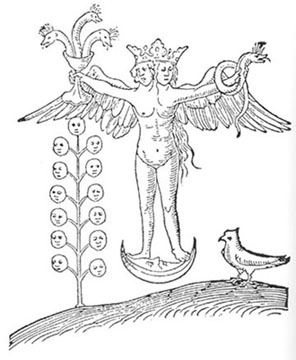 |
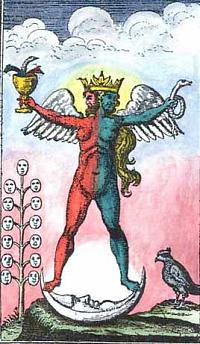 |
| Two depictions of the androgyne | |
Alchemy & Mysticism: The Hermetic Museum, by Alexander RoobLeft: The androgyne, as depicted in Alexander Roob's, "Alchemy & Mysticism: The Hermetic Museum.
Right: 18th Century depiction of Rosarium Philosophorum, coloured and showing many of the dichotomies present within the image (note the sun/moon base, the male half as red/female half as blue, half of the sky red, the other half blue, etc.) In other depictions, two trees would be present; one of them comprised of strictly red suns, and the other white moons, to further reinforce the concept of the androgyne/rebis
Above in Both: The tree of hermetic initiation, characterized by seven degrees
"'Here is born the noble empress rich/ The masters say she is like here daughter. She multiplies/ produces children numberless/ The are immortally pure/ and without nourishment. (...) I became a mother/ and yet remain a maid/ And was in my essense lain with. That my son became my father/ As God has decreed in essential way. The mother who gave birth to me/ Through me will be born on earth.' Rosarium philosophorum, 1550"
In the background of the single are a myriad of alchemical symbols. Common recurring symbols include those of mercury (the feminine, liquid, and passive) and sulfur (the masculine, fiery and active). Other symbols include triangles and inverse triangles (representative of fire and water, respectively), and stylized planetary symbols for Jupiter, Saturn, and Mercury (top left hand corner).
It is likely that the showing of several of the classical planets is once again being evoked to recall the maxim, "It is finished when seven are one", the graphical depiction frequently used in Machina. To demonstrate the union of the seven classical planets in one symbol, it simultaneously serves to represent the harmonious union of all of the properties for which they represent. For when the alchemist accomplishes this task and manifests it through his will the great work is complete.
Mirroring Plate II: THE SOUL AS LIVING PROOF, three serpents are brandished in one hand, and a single crowned serpent is held in the other. The noticeable change in this instance is that the hands have reversed, from the crowned serpent being in the left hand in plate II, to the crowned serpent being in the androgyne's right hand, in this depiction.
From behind the androgyne, a great lion springs forth. The lion can be equated with gold -- living gold -- the vitriol of which the alchemist pours all of their study and energy into creating. The gold is reflective of Rubedo, the final stage of the alchemical process, reflecting transcendence of the alchemist and the soul ascended.
Nigredo and Albedo are also present, depicted in the form of four great swans. The first, a large black swan, recalls Nigredo. As Nigredo is synonymous with a death, its blackened eggshell is broken apart, and hatching from the eggs are three white swans. In order to come into the world, they must break the egg apart, piece by piece, until they are freed. This is similar to the transition from Nigredo to Albedo; in order for the whitening of Albedo to come about, a death or moment of great blackening must first serve as its impetus.
Of final importance, the alchemist stands upon three serpents, like the three minerals of the great work: Sulfur, Mercury, and Salt. Sulfur in this case represents the fiery facet; Mercury is the liquid facet, and Salt is the facet of form. This, along with the triple crown that the androgyne wears, shows the alchemist's mastery over the three primary elements of the great work.
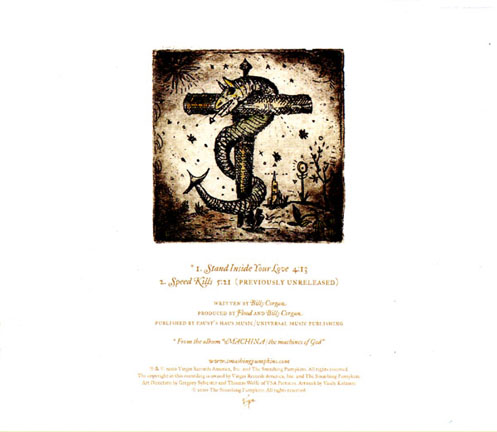 Interior artwork of the 'Stand Inside Your Love' single
Interior artwork of the 'Stand Inside Your Love' singleA biblical story of the Old Testament accounts for the majority of symbolism present within this drawing. The tale in question regards a journey by the Israelites from Mount Hur to the land of Edom, led by Moses. After a significant amount of time goes by, the Israelites become discouraged and begin to openly doubt and blaspheme Moses and their God.
Doing what he does best in the Old Testament, Jehovah inflicts great suffering on his "chosen people", sending a plague of serpents to the Israelites, which in turn poisons and kills a great many of them.
When the Israelites realize that they have brought divine wrath upon themselves and blasphemed against God, they ask Moses to pray for mercy and to pray for the disappearance of the serpents. Moses does this, and God in turn tells Moses to "Make thee a fiery serpent and set it upon a pole". If they do this, God assures Moses that "every one that is bitten, when he looketh upon it, shall live".
Below is the passage in question:
Numbers 21:4-9 (KJV)4 And they journeyed from mount Hor by the way of the Red sea, to compass the land of Edom: and the soul of the people was much discouraged because of the way.
5 And the people spake against God, and against Moses, Wherefore have ye brought us up out of Egypt to die in the wilderness? for there is no bread, neither is there any water; and our soul loatheth this light bread.
6 And the LORD sent fiery serpents among the people, and they bit the people; and much people of Israel died.
7 Therefore the people came to Moses, and said, We have sinned, for we have spoken against the LORD, and against thee; pray unto the LORD, that he take away the serpents from us. And Moses prayed for the people.
8 And the LORD said unto Moses, Make thee a fiery serpent, and set it upon a pole: and it shall come to pass, that every one that is bitten, when he looketh upon it, shall live.
9 And Moses made a serpent of brass, and put it upon a pole, and it came to pass, that if a serpent had bitten any man, when he beheld the serpent of brass, he lived.
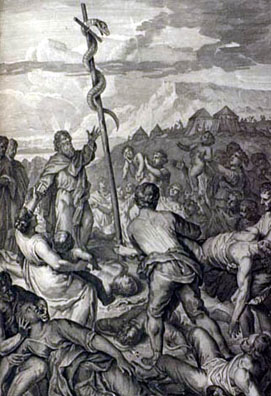 Moses and the Israelites erect the serpent's cross
Moses and the Israelites erect the serpent's crossThis tale became popular among occultists, alchemists and Gnostics alike, and was used as a parable of more alchemical and esoteric concepts.
What particularly fascinated the Gnostics with the image of a serpent on the cross was directly linked to their entirely differing view of the serpent from traditional orthodox teachings. While the serpent quickly became demonized by the church and equated with Lucifer and Satan, the Gnostics regarded the serpent as the wisest of all creatures, and so equated it with their Aeon of wisdom, Sophia (which name itself, means wisdom).
For the unfamiliar, Aeons, of which there are dozens, are the divine emanations of the most perfect being, whose name is ineffable. Even to use the term God or Lord would be diminutive of its unfathomable glory. Aeons could somewhat be compared to the similar concept of angels being messengers of the divine.
Regardless, the Gnostics noted the parallel between the healing power of Christ upon the cross and the healing power of the Israelites' brazen serpent upon the cross as the solution to all that which is volatile. By taking a creature known for its venomous bite, and turning it into a symbol of purity and cleansing, the Gnostics saw this as a beautiful depiction of mankind's ability to overcome their base and destitute nature and themselves become divine splendors of wisdom and purity, worthy of the healing powers of Christ and the serpent.
In addition, in the added context of the snake as a messenger of Sophia (Wisdom), it drew a connection between the salvation of Jesus Christ upon the cross, and the salvation through gnosis that the serpent offered.
Another telling example of the healing quality of the brazen serpent is revealed in the plants. The closest plant facing away from the serpent wilts and droops, while those that face toward the serpent stand up strongly.
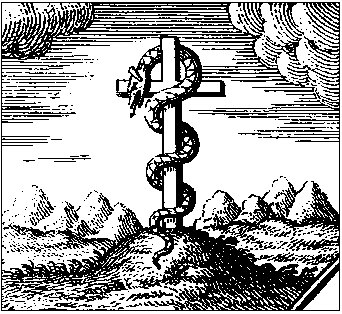 |
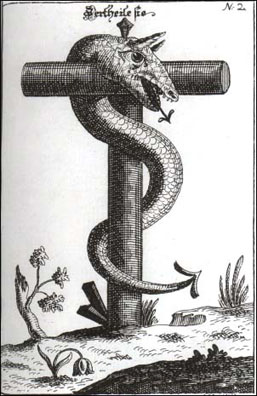 |
|
Left: Nicolas Flamel's early depiction of the crucified serpent. Right: Depiction of the crucified serpent which served as the basis for the sketch. Many similarities are present: the wilting flower, the shape of the cross, the positioning of the coiled serpent. The significant difference is that the sketch drawn for the Smashing Pumpkins is horizontally flipped. |
|
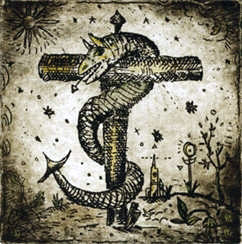 |
 |
Finally, presiding over the serpent are the two halves of alchemical union, Sol and Luna. Another telling example of the healing quality of the brazen serpent is revealed in the plants. The closest plant facing away from the serpent wilts and droops, while those that face toward the serpent stand up strongly, particularly the plant with the head of Sol.
To the right; the plant depicting the alchemical symbol for Sol, the Sun, amalgamated with into one living entity with Luna, the Moon.
